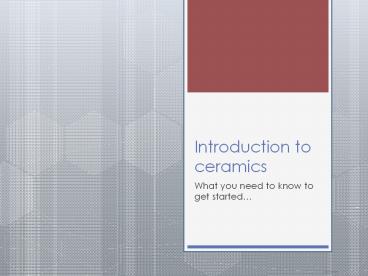Introduction to ceramics - PowerPoint PPT Presentation
1 / 18
Title:
Introduction to ceramics
Description:
Clay can be formed on the potters wheel. A lump of clay is magically transformed into a vessel. Video clip: tips for . Throwing a . Tall cylinder – PowerPoint PPT presentation
Number of Views:1008
Avg rating:3.0/5.0
Title: Introduction to ceramics
1
Introduction to ceramics
- What you need to know to get started
2
Clay is..
- Weathered, decomposed Granite (rock). A Clay
Body, is pure clay mixed other materials to make
a desirable colour and texture of clay. - Earthenware the type we will use. Fired at
1015-1200 C comes in red or white This is a
LOW FIRE clay. Other clays are fired much
hotter! - Stoneware Clay fired at 1200-1250 C.
- Porcelain Fired at 1250-1350 C. Very fine
clay. When it is fired it looks almost
translucent.
3
Most clay objects are mass produced using casting
slip and a mold
slip is liquid clay. Molds are made and the
slip is poured in. Many identical molds can be
made and this is the way ceramics can be mass
produced. Video link casting a cup
Video link Casting
4
Clay can be formed on the potters wheel
A lump of clay is magically transformed into a
vessel
Video clip tips for Throwing a Tall cylinder
5
Clay can also be formed using HAND BUILDING
TECHNIQUES
- No wheel is required.
- The results are unique and equally valid
- Technique 1Pinch Pots
Pinch Pots are created by inserting your thumb
into a small clementine sized ball of clay.
Slowly pinching in 3 rounds to thin the walls to
an even thickness.
6
Technique 2 Coil
- worms of clay are rolled to an even thickness
and stacked one on top of the other to create any
type of vessel you wish.
7
Technique 3 Slab
- After wedging, clay is rolled out into a sheet
that is even thickness. - It can be made into a variety of things from a
mug, bowl, vase, platter
These pieces have been textured when the clay is
still moist
8
Process working with clay Air OUT Moisture IN
- Air Out
- Wedge the clay to rid it of air. Trapped air
will cause your piece to blow (up) or at lease
break. - Moisture in
- While working with your clay, keep it wrapped in
plastic. Then it will be workable the next day.
Otherwise you will have to start over.
9
Process
- Build your piece 2-6 days
- Let it dry 1-2 weeks (covered at first so it
dries slowly)
At this point your potter is called GREENWARE.
It is very, very delicate because the moisture is
leaving it and it is dry an fragile.
10
Process First FiringBisque
- When your piece is TOTALLY DRY, your teacher will
place it in the KILN - This is the first, or BISQUE firing
- Your clay will harden and SHRINK by 15
11
Kilns so many different types
- A kiln is a heating chamber for pottery
- You can heat by electricity, wood
A typical oven cooks at 350 degrees Fahrenheit/
176 C. Our kilns reach 1200 C or 2192 degrees
Fahrenheit A hot day is 32 degrees C or about 90
degrees Fahrenheit
12
Wood firing kilns
A firing mould in Africa
A tile kiln
A charcoal kiln
13
Safety in the ceramics studioThe Kilns
- They are very hot. Dont touch them or place
anything on them. Assume they are ON. - Fumes firing pottery gives of a smell. We have
an EXHAUST HOOD above the kilns to take away
fumes. - There should be no physical horseplay in the
studio. No pushing, shoving, tripping. Someone
could fall into the kilns and be burned. Any
behaviour such as this will result in losing
privileges in the studio.
14
Colour on Pottery
- We use two kinds of colourants on pottery
- 1 UNDERGLAZES
- They can be put on greenware or bisqued pottery
- You may mix them and use them like paint
- They fire to a MATTE surface
- If you want them to be shiny you must put a clear
glaze over them and fire a second time.
15
2 Glazes
- Glazes are applied AFTER the bisque firing
- They are colour plus shine all at once
- They should not be mixed together
- Some are opaque and some are translucent.
Glossy Glaze shiny
Matte glaze not very shiny
16
Second firing glost/glaze
- Once the piece has been glazed with its final
coat, it must go into the kiln a second time. - The process from start to finish is about 3
weeks, including building, drying, firing,
glazing, firing.fini!
17
Other safety concerns
- Sharp tools be careful using exacto knives and
b3knives. Use common sense - Electric shock often we will have hair dryers
out to speed up drying. NEVER, NEVER let them
touch water. - Silica Silica is a component of clay. When it
is moist, it is not a problem. As clay dries and
becomes dusty, it is easily inhaled. CLEAN
CLAY UP WITH MOIST SPONGES DO NOT SWEEP OR
BLOW DUST AROUND
18
Finally
- In order for us ALL to enjoy this class, we have
to agree to clean up after ourselves always, and
to help others when asked. - Clay is messy. Tools get messy. Hands get
messy. Rolling pins get messy. It all has to be
cleaned before being put away. If you do not
clean it and you put it away dirty, the clay
dries, becomes dusty and then poses a health risk
to everyone. Please do your part and help others
when possible.































